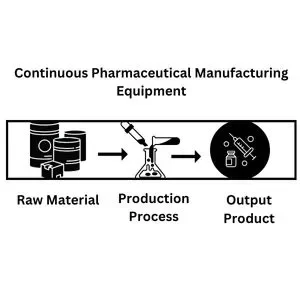Continuous pharmaceutical manufacturing is a new concept that allows pharma manufacturers to produce drugs in one single process, by eliminating intermediate processes
Continuous pharmaceutical Manufacturing is a new trend in the pharmaceutical industry for manufacturing products. It focuses on altering existing manufacturing methods where a product goes through lengthy, modular, and time-consuming Manufacturing, quality, and packaging procedures.
The pharmaceutical industry is adopting this new manufacturing technology worldwide, and regulatory bodies are also developing regulations for this new concept.
What is Continuous Pharmaceutical Manufacturing?
Continuous Manufacturing is a pharmaceutical product manufacturing process where a pharma product is manufactured in one operation and goes – from raw material to the final finished product. There are no intermediate steps during product manufacturing. The manufacturing process is not stopped in between for sampling, testing, or for transferring the product to other facility or equipment.
A single continuous manufacturing process consists of all the relevant steps and requirements as the product advances during its manufacturing stages. The process starts as the raw material is fed to the equipment and is only stopped at the final product discharge. All the product sampling and testing are carried out in line during the process. Quality parameters are also adjusted, if required, during the continuous manufacturing process.
Continuous Pharmaceutical Manufacturing Equipment
The continuous manufacturing process requires specialized equipment design that allows all processes of conventional equipment to be integrated into a single design. The output of each stage directly becomes the input of the next module without taking the product out of the equipment. It eliminates holding time for immediate quality checks such as sampling, testing, and waiting for results.

Intelligent systems at each stage continuously monitor the product. They allow for setting up a baseline for acceptable quality parameters. They also enable monitoring of the manufacturing process against these baseline quality variables.
Process Analytical Technology- PAT is the method to set up, monitor, and implement quality parameters in real time.
Process Analytical Technology – PAT
Process Analytical Technology – PAT is a technique in the Continuous Manufacturing industry that performs quality measurements in real time without halting the process. It also enables the process to adjust the quality parameter automatically if these drifts from the standard ones. This contrasts conventional analytical techniques, which depend on humans to perform quality parameter measurements. It also requires humans to perform process and product improvement actions.
PAT allows the setup of Critical parameters of the manufacturing process and then monitors the actual production process against these critical parameters.
Process Analytical Technology – PAT works in real-time to adjust the production parameters. This allows greater control of product quality and process safety. It works on the principle of Quality by Design – QbD, where quality is inserted into the final product by design.
Process Analytical Technology Structure
Process Analytical Technology – PAT is not a set of analytical or process instruments. Instead, it is a comprehensive system with a combination of different physical measuring instruments and software to perform real-time monitoring of reaction systems during production processes such as in Food and Pharmaceuticals.
The PAT structure can be divided into the following
Analytical Instruments
Analytical instruments perform various online product parameter measurements. These instruments use the light spectrum to monitor the ongoing process and characterize different quality attributes.
The output of these instruments is a function of various wavelengths and frequencies, called Spectral Data. These spectral data contain critical information that needs to be processed or decoded.
Some examples of analytical instruments for PAT include Near – Infrared and Raman spectroscopy.
Software System
The output of these analytical instruments is fed to a software system to process, analyze, and perform the final decision. It is used to predict product quality and compare with the acceptable limits.
Pharmaceutical Continuous Manufacturing Regulatory Considerations
Continuous Manufacturing in pharmaceuticals is a new concept, and all stakeholders are preparing themselves to cope with this new technology. Regulatory bodies are also developing regulations and guidelines for the pharmaceutical industry to prevent quality compromise.
Following is a brief regulatory guideline related to Continuous Manufacturing around the world
ICH Guideline
The ICH guideline “ICH guideline Q13 on continuous manufacturing of drug substances and drug products – Scientific guideline” describes considerations for developing, implanting and operating continuous manufacturing operations.
US FDA
The United States, FDA guidance document “Advancement of Emerging Technology Applications for Pharmaceutical Innovation and Modernization” describes ways and procedures for transition to Continuous Manufacturing from batch manufacturing procedures. It provides details about how to upgrade equipment, quality procedures, production capabilities and personnel expertise to continuous manufacturing type.
Another FDA guideline, known as “FDA Guidance on Process Validation/Continual Verification” about the validation of Process validation of continuous manufacturing system. This guidelines is all about the modern techniques and applications in pharmaceutical product development, quality principles throughout the product manufacturing cycle.
Another FDA guidance document “PAT-A Framework for Innovative Pharmaceutical Development, Manufacturing, and Quality Assurance” emphasizes risk based approach to process design. It concentrates on alternate laboratory-based testing methods such as On-line, In – line and at-line measurement of quality attributes for controlling the product and process quality.

